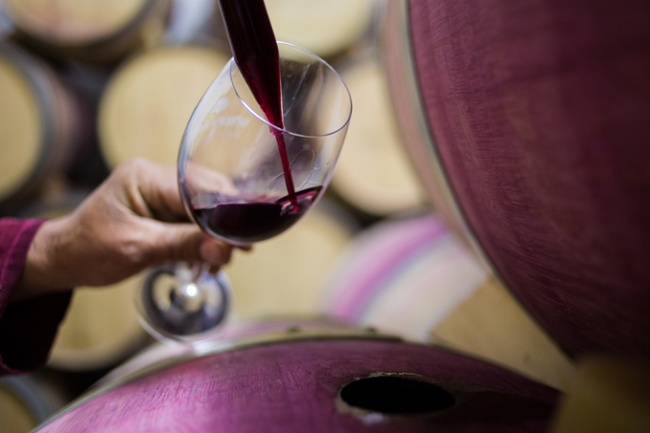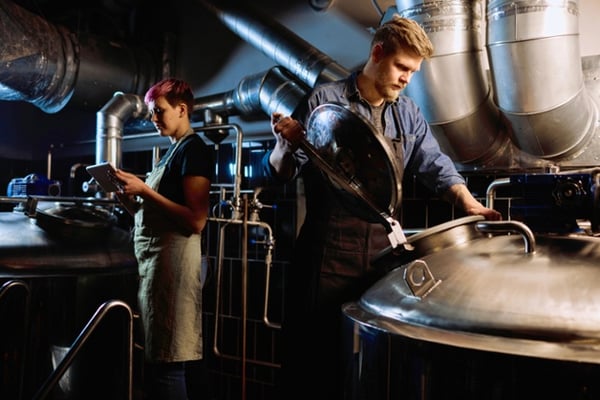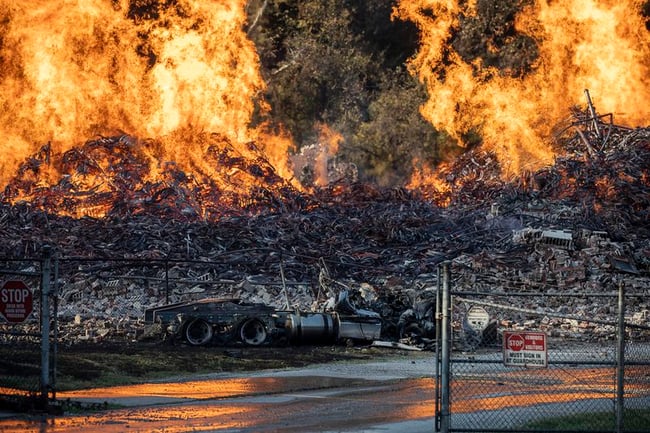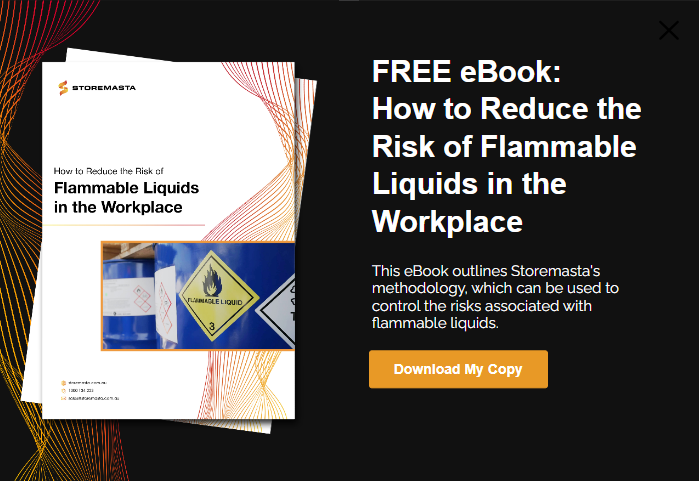Working with flammable liquids is just part of the regular working day when you operate a winery, brewery or distillery. However, the flammability of alcohol raises some serious questions about safety – especially when you’re decanting. In this blog, we look at the dangers of static electricity when decanting flammable liquids – and how you can get a good drop without risking the safety of your staff and your enterprise.
Working With Ethanol and other Flammable Liquids
From micro-breweries to wineries and major distilleries, if you’re producing beer, wine or spirits, you’re working with Class 3 Flammable Liquids.
And while Dangerous Goods are the last thing on anyone’s mind when they’re enjoying their favourite drop, it’s essential that brewers, wine makers and distillers understand the risks associated with the production of alcohol.
Producing beer, wine and spirits involves the production of ethanol, which is classed as a highly flammable liquid.

Wine makers, brewers and other beverage manufactures often use flammable liquids in their operations.
What are the Dangers of Static Electricity?
Static electricity can do more harm than simply cause discomfort when you feel that unexpected zap. Static electricity hazards range from damage to electronic equipment due to electrostatic discharge through to fires or explosions when flammable or explosive materials or mixtures ignite.
There have been countless incidences across the globe where premises have been ravaged by fire or destroyed by an explosion due to static electricity buildup causing a flammable liquids fire or explosion.
One of the most shocking high-profile incidences occurred in 2019 when a Jim Beam warehouse in Kentucky went up in flames – taking with it 45,000 barrels of bourbon.
Alcohol-fueled blazes, just like any flammable liquids fire, are notoriously fast burning, fierce and difficult to extinguish. The Jim Beam fire caused approximately $US300 million worth of damages. It also caused environmental damage as the liquor reached the nearby river and impacted the aquatic life.
Fire and explosion are serious risks associated with the production of alcohol.
While fires such as this are catastrophes that harm people, property and the natural environment, ignition sources – including static electricity – can result in a range of issues for businesses that produce alcoholic drinks.
We’ve heard storing from Australian producers, who claim that they have witnessed explosions in their distillery caused by static electricity igniting their flammable liquids. While some of these incidences may have been able to be successfully contained, it’s vital that anyone working with ethanol is trained in flammable liquids safety.
But how can static electricity occur in a workplace? We’ll now look at some of the ways that a charge can be unknowingly created — and how this can be controlled.
How Static Electricity Can Be Generated?
We’ve all experienced static electricity on a regular basis. Whether it’s the fabrics of the clothes that we’re wearing or the weather conditions, many factors can affect the creation of static electricity. For example, hazards may occur when splash filling static electricity ignites a Class 3 flammable substance during the decanting process.
In the most basic of terms, static electricity occurs due to the friction of two things which are constructed from different substances. The electric charge which is generated from the static electricity is often noticed because it creates an uncomfortable static shock upon contact.
While static discharge is as common as brushing your hair, drying your clothes, jumping on a trampoline or touching a car door handle, it’s a harmless shock that produces only mild discomfort.
A real-life example of a static charge causing a flammable liquids fire.
However, when you’re working with flammable liquids, static charge can turn a simple task such as decanting into a potential fire or explosion hazard. Understanding how static charge is creating and having the ability to control the risks is crucial when you’re working in a facility such as a winery, brewery or distillery.
What Substances Increase The Risk Of Static?
As we’ve explained, static electricity is the result of a buildup of electrical charge on an object. The friction caused in everyday activities, such as walking on certain surfaces or the rubbing of fabrics, can create a buildup of static on human skin. When you touch another item or brush past another person, then the static will discharge.
There are certain materials or surfaces that create more static electricity than others. Some of these include:
- Human hair
- Dry skin
- Nylon
- Polyester
- Silk
- Aluminium
- Brass
- Copper
- Nickel
- Silver
- Gold
- Platinum
- Teflon
- Vinyl
- Polyurethane
- Polypropylene
Of course, there are some materials that don’t present a static charge risk, such as cotton and steel. Understanding which materials are neutral and which increase the likelihood of static charge is the first step to controlling the risk of fire or explosion during the decanting process.
Risks Of Static Charge When Decanting Flammables
During the decanting process, there are many opportunities for static electricity to occur. Static electricity, when working with flammable liquids, can cause a range of hazards including:
- Spark
- Fire
- Explosion
- Human harm
To reduce the risk of static occurring in your business, you should conduct a risk assessment of every area that handles or stores flammable liquids to determine the hazards and level of risk that’s present at your site.
How Could Static Be Created?
Consider the following items and how they could affect the likelihood of static electricity in your winery, brewery or distillery:
- Clothing – is the clothing worn by workers contributing to the possibility of static electricity?
- Shoes – what footwear do your staff wear when decanting flammable liquids?
- PPE – are staff wearing PPE that is specifically made for the handling of flammable liquids?
- Flooring – could the flooring in your decanting areas add to the possibility of static?
- Decanting equipment – is your decanting equipment properly fitted; it is made from an appropriate material?
- Flammable liquids container – what material is your container made from and will it react with your decanting equipment?
Requirements For The Decanting Of Flammable Liquids
When you’re working with any type of flammable liquid, it’s good practice to follow the requirements of the Australian Standards. Not only does this allow you to develop procedures that are safe and compliant – it also enables you to meet your legal obligations under the WHS Regulations.
AS 1940:2017 - The storage and handling of flammable and combustible liquids details some precautions for staff who are handling flammable liquids.
Section 2.3.2 Operations states that:
(d) Care should be taken when decanting or transferring flammable liquids. Dispensing
pumps or self-closing metal taps should be used, in order to reduce the hazards of
splash filling, spillage and vapour escape.

Static electricity can be created when materials rub together, therefore staff must be dressed in materials that reduce the risk of static charge.
Not only can the decanting process cause static electricity and the ignition of flammable liquids — decanting can also increase the risk of:
- Chemical spills – increasing the likelihood of fire, flash back or explosion
- Emission of hazardous vapours – resulting in asphyxiation and increased fire risk
- Asphyxiation and human harm – when vapour emissions exceed legal limits
- Environmental damage – pollution may occur when flammable liquids enter soil or waterways
IMPORTANT: Whenever flammable liquids are handled or decanted in the workplace, the utmost care must be taken to ensure that the risk of chemical spills is controlled and managed. Bunded storage, floor bunding, using the correct decanting equipment, compliant flammable containers and strict operational procedures and staff training can assist in creating a safer decanting process.
Recommended Control Measures: Earthing And Bonding
So, what control measures would help reduce the risk of vapour ignition due to static electricity?
The Australian Standard offers excellent guidance on how to further control ignition sources. Specifically, the Standard details the earthing and bonding of equipment to reduce static electricity and the associated hazards.
<H3> Australian Standards Static Electricity Requirements
In Section 9 Operational and personnel safety, the Standard states that:
9.2.7.4 Earthing and bonding
Static electricity shall be controlled in accordance with AS/NZS 1020. Lightning protection
shall comply with the requirements of AS/NZS 1768. Earthing shall comply with
AS/NZS 3000.
The Standard then goes on to explain that bonding and earthing are not the same thing and shouldn’t be confused with each other. Bonding is the process of connecting all items where static electricity may buildup. However, earthing discharges dangerous electric currents into the ground. It does not provide the continuous circuit required for bonding and should not be used to control static.
For example, in a brewery or distillery, you should ensure that the flammable container, decanting equipment and receiving equipment is continuously bonded throughout the process of decanting, in order to reduce the opportunity for static buildup.
Static Electricity Safety
As we’ve highlighted in this blog, static electricity is a form of ignition that can lead to fire, explosion and human harm. When working with ethanol or any type of flammable liquid, it’s important that the friction between two incompatible substances is avoided. Only work with compliant decanting equipment that’s suitable for the work you’re carrying out and ensure that all clothing, PPE and containers are made from materials that won’t create a static charge. Would you like to learn more about reducing your risks? Access our free guide, How to reduce the risk of flammable liquids in the workplace, to learn more about our effective risk control methodology IDENTIFY – ASSESS – CONTROL – SUSTAIN. This risk control process can be easily applied to any workplace that carries Class 3 Flammable Liquids, including wineries, breweries and distilleries.

Living life by the 4 C’s of marketing – communication, coffee, compliance… and more coffee – Leisa Andersen is Storemasta’s Content Marketing Manager. When she’s not writing, you’ll find her enjoying all the good things in life, including shopping, travel and gluten free donuts.

